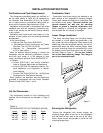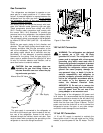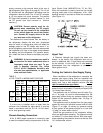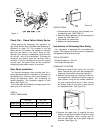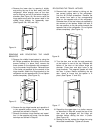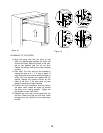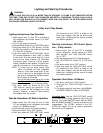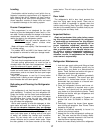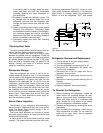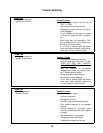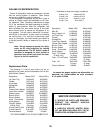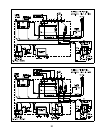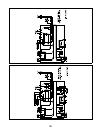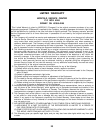
is not being used for storage. Keep the refrig-
erator area clear and free from combustible
materials, gasoline, and other flammable va-
pors and liquids.
9. Periodically inspect the ventilation system. The
air passage from the bottom intake vent to the
refrigerator coils and from the refrigerator coils
through the upper exhaust vent must be unob-
structed.
10. Inspect combustion seals (visual check without
removing the refrigerator). Combustion seals
are attached the back surfaces of the refrigera-
tor’s mounting flanges and must be continuous
between the wall and the mounting flanges to
assure a complete combustion seal.
11. Periodically inspect door seals. See "Checking
Door Seals" below.
Checking Door Seals
To insure cooling efficiency and to prevent frost for-
mation, the door gasket must seal completely.
To check for proper door seal, lay a strip of paper
between the gasket and the refrigerator. Close the
door and withdraw the paper. A frictional drag should
be noticed. Repeat all around the door. If the paper
does not have a noticeable drag, the gasket is not
sealing. Contact your dealer or a Norcold service
center for corrective procedures.
Refrigerator Storage
When the refrigerator will not be in use for an ex-
tended (seasonal) period of time, it is recommended
that all power to the refrigerator be disconnected. Un-
plug the refrigerator’s AC power cord from the wall
receptacle and disconnect the 12 volt DC from the
refrigerator’s terminal block located at the rear of the
refrigerator. Clean the refrigerator interior and leave
the door(s) open to keep the interior odor free. After
the extended shut-down period, the burner, burner
orifice, and flue must be inspected before igniting the
burner flame. These areas must be free from dust,
spider webs, or other obstructions which might re-
strict the combustion system.
Burner Flame Inspection
The efficiency of your refrigerator while operating in
the gas mode is independent upon the correct burner
flame. The burner flame provides energy to the re-
frigerator’s cooling system.
The burner flame efficiency is a function of correct
input gas supply pressure, air input, and burner and
burner orifice cleanliness.
A visual check of the burner flame should be made
regularly. The flame should be sharp blue with a sta-
ble burning appearance (Figure 22). If there is a con-
stant yellow component observed or if the flame ap-
pears erratic or unstable, switch the refrigerator to
electric or turn the refrigerator "OFF" and contact
your dealer or a Norcold service center.
Refrigerator Removal and Replacement
1.
1. Turn off the gas at the main supply tank(s).
2. Turn the refrigerator off.
3. Turn the refrigerators manual shut-off to off.
4. Disconnect the refrigerator’s AC power cord
from the wall receptacle.
5. Disconnect the 12 volt DC supply from the re-
frigerator’s terminal block.
6. Disconnect the LP gas supply line from the re-
frigerator.
7. Remove the mounting screws securing the re-
frigerator
or to the enclosure.
8. Remove refrigerator form the enclosure.
To Reinstall the Refrigerator:
1. Before reinstalling the refrigerator, inspect the
areas behind the mounting flanges for dam-
aged or missing seal strips (combustion seals).
These seal strips serve as a combustion seal
which isolates the living space of the vehicle
form the refrigerator’s combustion system.
2. Reinstall the refrigerator by reversing the above
procedures.
3. After reinstalling the refrigerator, check the gas
fitting connections for leaks. Do not check for
leaks with an open flame. Use an approved
leak-detection solution.
Figure 22
18



